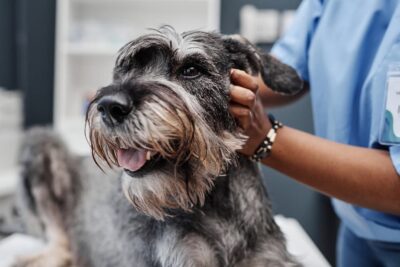Dog Spay and Neuter: Cost, Procedure and What to Expect

If you’re a new dog parent or just exploring ways to keep your furry friend healthy and happy, you’ve probably heard your veterinarian talk about the importance of spaying or neutering. These procedures are some of the most common and beneficial surgeries we perform in veterinary medicine.
According to the American Veterinary Medical Association, millions of dogs are spayed or neutered every year in the U.S. alone. It’s considered a routine part of preventive care, and for good reason: these procedures can improve your dog’s behavior, reduce their risk of certain diseases, and even extend their lifespan.
Equally as important, by keeping pets spayed and neutered, we prevent unwanted litters. Since the ASPCA began promoting large-scale sterilization programs in the 1970s, shelter euthanasia rates in the U.S. have dropped dramatically; from an estimated 13.5 million animals euthanized annually in the early 1970s to under 1 million in recent years (1, 2). It’s a powerful reminder that these simple procedures can save lives, both in our homes and in our communities.
So let’s walk through everything you need to know about dog spay and neuter appointments, including the differences in the procedures, the general cost, what happens during surgery, and how to care for your pup afterward.
Understanding Dog Spay and Neuter Procedures

So, what exactly does it mean to spay or neuter a dog?
Neutering (also called castration or orchiectomy) is the surgical procedure performed on male dogs. It involves the removal of the testicles, which eliminates the dog’s ability to reproduce and significantly reduces testosterone levels.
Spaying (also called an ovariohysterectomy or ovariectomy) is the surgical sterilization procedure for female dogs. In an ovariohysterectomy, the veterinarian removes the ovaries and uterus. In an ovariectomy, the veterinarian only removes the ovaries. Both procedures prevent female dogs from becoming pregnant and stop heat cycles.
These surgeries are typically performed at your regular veterinary clinic, but they’re also available at dedicated spay and neuter clinics or through mobile veterinary services in some areas.
Dog Neuter Appointment
During a neuter surgery, your male dog will go under general anesthesia. The vet makes a small incision near the scrotum and removes both testicles. The incision is then closed with dissolvable sutures or surgical glue.
This procedure ensures that your male dog can no longer father puppies. It also helps curb certain hormonally-driven behaviors like roaming, mounting, and urine marking.
Dog Spay Appointment
For female dogs, a spay procedure is a bit more involved, as it requires entering the abdominal cavity. Under general anesthesia, the veterinarian removes the reproductive organs, depending on the surgical method used.
Both spaying techniques — ovariohysterectomy and ovariectomy — are equally effective at preventing pregnancy. They also stop heat cycles and the hormonal fluctuations that come with them.
Reasons to Schedule a Dog Spay or Neuter Appointment

Most pet parents know that spaying or neutering prevents unplanned litters — but that’s just the beginning of the benefits.
The major health benefits of spaying and neutering include:
- Reduced cancer risk: Spaying greatly reduces the risk of mammary (breast) tumors, especially when done before the first heat cycle. Neutering eliminates the risk of testicular cancer and decreases the risk of prostate issues in males.
- Prevention of uterine infections: Spaying prevents pyometra, a life-threatening infection of the uterus that affects nearly 25 percent of unspayed females before age 10 (3).
- Longer lifespan: Studies suggest that spayed or neutered dogs tend to live longer, healthier lives on average (4).
In addition to the health benefits of spaying and neutering, behavioral benefits include reduced territorial behaviors like marking or fighting, less desire to roam, which lowers the risk of accidents or getting lost, and decreased aggression in some dogs (though training and socialization are also key!).
At What Age Can You Spay or Neuter a Dog?
The general recommendation for most dogs is to schedule spay or neuter surgery between 6 to 12 months of age. However, the ideal timing can vary based on breed, size, and individual health.
- Most small breeds often mature faster and may be spayed or neutered closer to 6 months.
- Large and giant breeds may benefit from waiting until 12 months or longer to allow for full skeletal development before removing sex hormones.
Talk to your vet to determine the best timing for your pup. Pet parents often need to schedule spay and neuter appointments several weeks to months in advance, especially in busy clinics or nonprofit programs. While you wait, keep your intact dog securely leashed or in a fenced yard to avoid accidental mating. Remember, siblings will also mate, so be sure to separate male and female dogs as early as 6 months before at least one of them is sterilized.
Risks to Consider
Spay and neuter surgeries are considered safe, routine procedures — but like any surgery, they carry some risks. These include:
- Anesthesia complications (rare)
- Postoperative infection or swelling
- Temporary behavior changes during recovery
For most healthy dogs, the benefits outweigh the risks. There are no medically viable alternatives to surgical sterilization that are as effective and permanent, although some pet parents may consider vasectomy or hormonal treatments in very specific situations (these are far less common and not widely recommended).
Cost to Spay or Neuter a Dog
The cost of dog spay or neuter surgery can vary widely based on your location, your dog’s size, and whether you go through a private veterinary hospital or a low-cost spay and neuter clinic.
Here’s a general breakdown:
- Neuter (male dog): $75 to $500
- Spay (female dog): $200 to $1,000
Spaying tends to be more expensive because it is a more involved surgical procedure. Some clinics include pre-operative blood work, catheterization and intravenous fluids, pain medications, and post-op care in their pricing (all of which help avoid potential complications and mitigate risks) while others charge separately or do not perform them, such as high volume spay and neuter clinics.
Many communities offer low-cost spay and neuter programs through local animal shelters, rescue organizations, or veterinary nonprofits. These programs may have income eligibility requirements but are a great resource for pet parents on a budget.
Dog Spay or Neuter Appointment: What to Expect

Here are a few things to expect prior to your pet’s surgery:
- Your vet will give you pre-op instructions, usually including a fasting period (no food after midnight the night before surgery).
- Water is typically allowed, as maintaining hydration is important for anesthesia and recovery.
- Preoperative blood work is always recommended, and at some clinics even required, so we can ensure your dog does not have any pre-existing conditions that could interfere with anesthesia or recovery.
- Administer any medications as prescribed by your veterinarian, sometimes called a “comfort pack,” to help prevent anxiety and nausea that commonly occur with surgery.
- Consider exercising more often in the days leading up to surgery since your dog will need to rest after the procedure.
Day of Surgery:
- You’ll drop your dog off at the clinic in the morning.
- Your dog will have a preoperative physical exam to ensure they are healthy for surgery.
- At typical veterinary clinics, your pet will have an intravenous (IV) catheter placed for fluid administration.
- Your dog will receive general anesthesia. Veterinary staff will monitor this throughout the procedure (unless your pet is at a low-cost spay and neuter clinic).
- The actual surgery usually takes 20–60 minutes, depending on the dog’s sex, size, and age.
- Once the surgery is complete, staff will move your dog to recovery and assess their pain level. They will provide medications or additional support, like warming, if needed.
- Most dogs go home the same day once they’re awake and stable. In some cases, especially for large spays or dogs with complications, an overnight stay might be recommended.
Dog After Spay or Neuter Surgery: Care Tips and Advice

Recovery usually takes 10 to 14 days, and most dogs bounce back surprisingly fast. Still, there are important steps you’ll need to take at home:
- Limit activity for at least 10–14 days. No running, jumping, or rough play.
- No baths or swimming until the incision is fully healed and cleared by your vet.
- Use an Elizabethan collar (cone) or a recovery suit to prevent licking or chewing at the incision.
- Monitor the incision site daily for signs of infection (swelling, heat, redness, discharge, or odor).
- Give any prescribed pain medications or antibiotics exactly as directed.
Your dog may be sleepy, groggy, or quiet the first night after surgery. Mild swelling around the incision site is normal, but it should not be red, hot, or oozing. Some dogs may experience decreased appetite and constipation for a day or two and is not a cause for concern.
If your dog seems lethargic for more than 24 hours, has vomiting, diarrhea, difficulty urinating, or you notice anything concerning at the incision site, call your vet right away.
Final Thoughts
Spaying or neutering your dog is one of the most important steps you can take as a responsible pet parent. Beyond preventing surprise puppies, it’s a proactive way to support your dog’s long-term health and improve their behavior, and in many cases, it can save you money and stress down the road.
As always, if you have any questions about your dog’s individual needs or how to prepare for surgery, don’t hesitate to talk to your veterinarian. We’re here to help guide you through every step of your pet’s care — and make sure both you and your pup feel confident and comfortable along the way.
References
- Rowan, Andrew, and Tamara Kartal. “Dog Population & Dog Sheltering Trends in the United States of America.” Animals: an open access journal from MDPI vol. 8,5 68. 28 Apr. 2018, doi:10.3390/ani8050068
- Pet Statistics. ASPCA. Retrieved from https://www.aspca.org/helping-people-pets/shelter-intake-and-surrender/pet-statistics
- Xavier RGC, Santana CH, de Castro YG, de Souza TGV, do Amarante VS, Santos RL, Silva ROS. Canine Pyometra: A Short Review of Current Advances. Animals (Basel). 2023 Oct 25;13(21):3310. doi: 10.3390/ani13213310. PMID: 37958065; PMCID: PMC10647846.
- Hoffman JM, Creevy KE, Promislow DE. Reproductive capability is associated with lifespan and cause of death in companion dogs. PLoS One. 2013 Apr 17;8(4):e61082. doi: 10.1371/journal.pone.0061082. PMID: 23613790; PMCID: PMC3629191.









